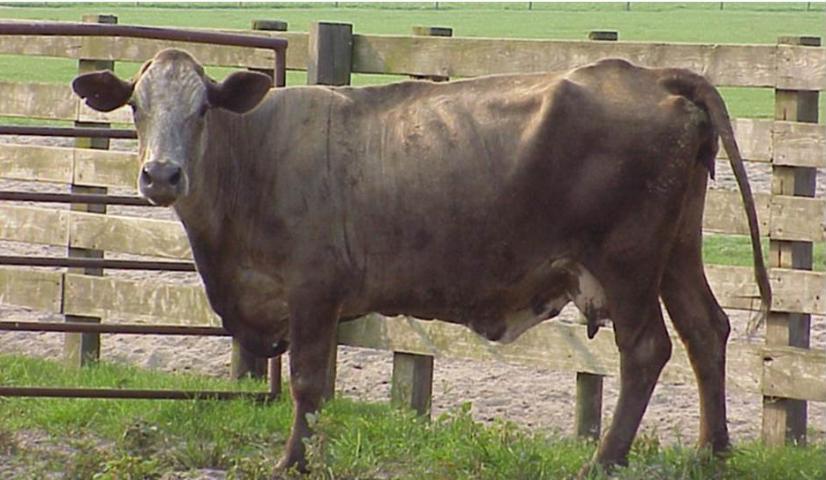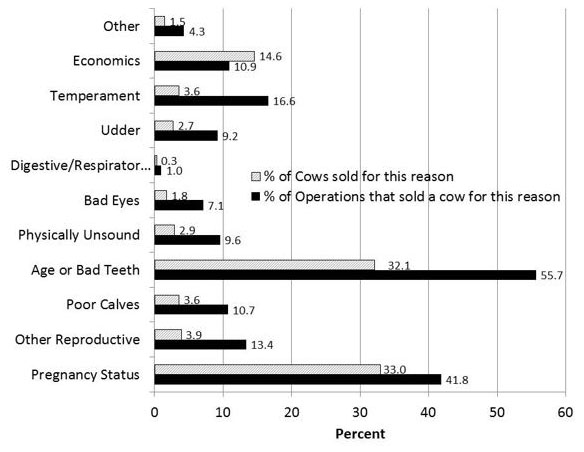
A cow with a Body Condition Score (BCS) 3. There are opportunities to increase the value of cull cows prior to marketing, particularly if they are below a 5 BCS when the decision to cull is made. For more information on evaluating BCS visit, Implications of Cow Body Condition Score on Productivity Credit: Matt Hersom, UF/IFAS
This week’s conversation about maximizing revenues centers on a topic that is generally not very popular with cattlemen – cull cows. I don’t know a single cattleman that enjoys culling cows from the herd. Unfortunately, for a variety of reasons, each year there will be a percentage of the herd that needs to be culled. Even though their time in your herd is ending, these cull cows have value, and their sale is an appreciable source of revenue. There are management decisions that can be made to help maximize the revenue generated through the sale of cull cows. Additionally, well thought out culling strategies can, over time, greatly increase the efficiency, productivity, and revenue generating potential of the entire herd.
Fifteen to 25% of revenues generated annually from a cow/calf operation come from the sale of cull cows – getting the most for your culls can make a big difference to your bottom line. Below are three principles to think about when marketing cull cows.
- Timing is crucial to maximizing cull cow revenues. In general/historical terms, the cull cow market becomes saturated in the fall, suppressing prices. From the first week in August through the last week in October cull cow prices will decline 8-12%. Cull cow prices tend to be the strongest March through May.
- Put some flesh on them. Cull cows are assigned a grade based body condition score (BCS). A BCS of 5 or higher puts cows into the Boning Utility or Breaker grade. Because of the increased yield associated with animals that are in better condition, cows in these grades generally bring higher prices per pound than Lean or Light cows. Extra condition also means additional pounds. More pounds at a higher price per pound means more revenue. If you have available forage, fleshing up cull cows prior to marketing them can be beneficial.
- Culls or replacements? The phases “cull cow” and “kill cow” are sometimes thought of interchangeably. This is not necessarily the case. Just because she no longer needs to be in your herd doesn’t mean she can’t find a home in someone else’s herd. A cow that no longer fits the breeding season or timing of your production system may still work for someone else. This is not the case for many culls, but in some situations holding select culls and allowing them additional time to become pregnant could result in selling value added bred replacements instead of kill cows.
–
Why cull?

Percentage of cows or operations that culled a cow, by reason. Credit: USDA. 2008. “Beef 2007–08 Part IV: Reference of beef cow-calf management practices in the United States, 2007–08.”
–
I can’t write an article about culling cows without relaying a wonderful piece of wisdom that was shared with me several years ago. A cattleman told me, “I cull cows based on the three “O”s – Old, Open, and Ornery.” That saying is easy to remember, to the point, and does a good job laying out an effective culling strategy. What follows is not nearly as easy to remember or to the point but perhaps it will be helpful.
There are lots of reasons why a particular cow no longer needs to be in your herd, but put into the simplest terms a cow should be culled when she is no longer able to generate annual revenue sufficient to cover the expenses associated with maintaining her. This boils down to her ability to become pregnant and raise a calf of acceptable quality.
As with so many things on the farm, when it comes to culling cows there is no one-size-fits-all answer. As we look at culling criteria as organized in the axiom above, consider the comments food for thought, not necessarily recommendations.
–
“Old”
The rationale behind culling based solely on age is to remove cows from the herd before age-related issues begin to impact the cow’s ability to rebreed in a timely manner and raise a quality calf. The logic associated with this approach is sound – sooner or later a cow will not rebreed and/or raise an acceptable calf. If the cow is still in the herd at that time, the carrying cost investment will already have been made with little to no chance for a return on the investment. More to the point of today’s article, cows culled solely on age can have real value and can be marketed in multiple ways (see above).
The standard argument against culling solely on age is also based on sound logic. This line of thought centers on the basic principle that the more calves a cow weans, the more profitable she is over her entire lifetime, which is a true statement, assuming calf value continues to exceed carrying costs. There is a trade-off between the two approaches. Culling on age lessens the risk of carrying unproductive cows and generates more valuable culls, where not considering age carries more risk but provides an opportunity for maximum lifetime returns from each cow.
The tipping point is when the cow will wean enough additional pounds (after the hypothetical culling age) to offset the lost carrying costs and reduced salvage value that will eventually come with age. In my opinion, identifying this tipping point for individual cows is an area where a cattleman’s knowledge and experience really come into play. A hard line on either side of the argument is probably less than ideal. Knowing your animals and being able to see the early signs that age is catching up with them will allow cows to be culled just on the right side of the tipping point. Checking older cows’ teeth can give you a valuable heads-up on problems to come.
–
“Open”
In Increasing Cow/Calf Revenue with Reproductive Management I discussed the importance of maintaining a defined breeding/calving season. I also mentioned the importance of timely pregnancy evaluation and the culling of open cows. Over time, culling open cows results in a herd that is highly functional in your management system, ultimately resulting in maximized revenue potential. However, it is important to note that a cow’s body condition score has a tremendous impact on her reproductive efficiency. If you are not managing your herd in such a way as to ensure adequate nutrition, culling cows based solely on their pregnancy status may not be a viable approach. If more than 20% of the herd is open at preg check time, there may be factors beyond individual cow performance involved. I have frequently used the phrase “hold cows accountable” in conversations about culling open cows, I stand by that phase when cows are well managed. However, when large percentages of the herd come up open, it may well be time to “hold the manager accountable”.
–
“Ornery”
Culling cows based on temperament could be an entire article on its own, but I will keep my comments very brief. Cattle with poor dispositions are a danger to themselves and the people attempting to work with them. If you can not safely work a cow through your facilities, cull her. It’s not worth the risk. That said, if temperament is an issue with a significant portion of your herd, it may be time to take another look at your facilities and/or handling techniques.
–
Physical Ailments
Physical ailments are an important reason for culling that was not captured in the “3 Os”. There are countless physical issues that can arise with a cow that will limit her future productivity, calling for her removal from the herd. Some examples that come to mind include bad udder, lameness, and cancer eye. Many of the conditions in this category worsen with time, making timely culling and marketing key to maximizing the salvage value of the animal and preventing animal welfare concerns.
This was by no means an exhaustive discussion on marketing cull cows or effective culling practices. For more information on the topics check out the additional resources linked below, contact me directly, or contact your county’s UF/IFAS Extension Office.
–
Additional Resources
Culling and Replacement Rate in the Beef Cow Herd
Cull Cow Quality Issues
Know the USDA Cull Cow Grades Before You Sell
Beef Cull Cow Management and Marketing Alternatives
Feeding Your Culls May be an Effective Marketing and Management Strategy
Estimating Cattle Age Using Dentition
